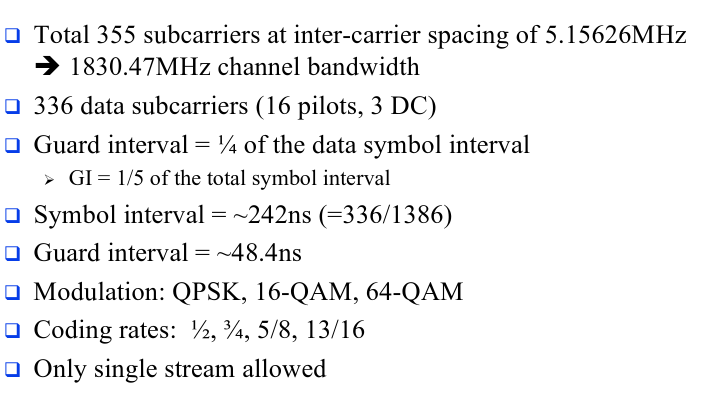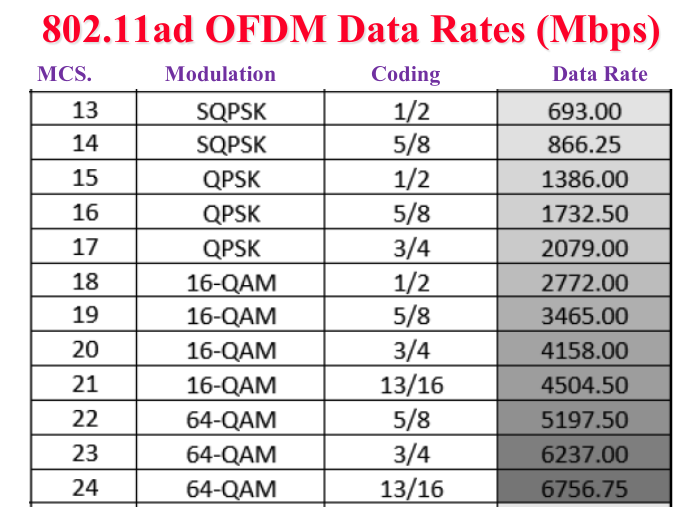802.11ad-2012 (WiGig)
Contents
60 GHz
Advantages
- Large spectrum - 7 GHz
- 7 Gbps requires only 1 bit/Hz (BPSK is okay)
- Complex 256-QAM not needed
- As the wavelength is very small, we only need 5/4 = 1.25mm of antenna separation
- Easy beamforming - antenna arrays on a chip
- Low interference - does not cross walls
- Directional transmissions - spatial reuse is easy
- Difficult to intercept
Disadvantages
However, as the frequency is very high, there is a large attenuation - attenuation / frequency^2
- Strong absorption by Oxygen
- Need large transmit power
- Need high antenna gain -> directional antennas
- Short distance -> ~10m
- Very directional - devices to be perfectly aligned
- Carrier sense not possible
- RTS/CTS doesn't work
- Multicast is different
- Easily blocked
Multi-Gigabit Wireless Application
- Cable Replacement
- Interactive Gaming
- High Speed File Transfer
- Wireless Mesh Backhaul (200-400m)
PHY Layer


Challenges at 60 GHz
- High path loss at 60 GHz
- 28 dB higher than 2.4 GHz WLAN
- 22 dB higher than 5 GHz WLAN
- Stations must have a high antenna gain to overcome the high path loss
- Directional beamforming assists in increasing the antenna gain
- Directional communication complicates MAC design
- AP can talk to a station only if their beams align
- Two stations can only communicate if both their beams align
Topology
- Personal Basic Service Set (PBSS) - the group of (up to 255) stations that communicate
- PBSS Central Point (PCP) - the 'access point' that provides scheduling and timing using beacons
- Any 802.11ad device can act as the PCP
- 1 PCP ber PBSS, 1-254 non-PCP stations
MAC Beacon Interval

Each superframe is called a beacon interval, and is divided into 4 access periods
- BT - Only the PCP can send a beacon, beings beamform training by sending training frames
- A-BFT - PCP performs training with its stations
- AT - PCP polls members and receives metadata responses (i.e. service periods (SP) - requests to transmit)
- DTT - STA-to-STA exchange happens
- Stations exchange data frames in their dedicated service periods (SP)
- Can also exchange data frames by contention in content-based periods (CBP)
CBP uses Distributed Coordination Function (DCF)
SP uses Hybrid Coordination Function (HCF)
Beacon transmissions are omni-directional.
i.e. One beacon is transmitted through every antenna configuration / sector
Question: An 802.11ad PCP/AP has a four-sector antenna with every sector covering 90 degrees. During a Beacon Time (BT), how many beacons the AP should transmit?
Answer - 4, as it needs to transmit the beacon to the 360/90=4 sectors
Beamforming Options
Exhaustive Search - examine all beam pairs
- $O(B1 x B2)$
- e.g 8x8 -> 64 pairs
- e.g. 32x32 -> 1024 pairs
Omni-directional Search (more below)
- Transmit on all beam directions
- Receiver uses an omni-directional antenna to record the RSS for all beam directions, and selects the one with the highest RSS
- The receiver then transmits on all beam directions
- The original transmitter then uses their own omni-directional antenna to record and select the highest RSS direction
- $O(B1+B2)$
Beamforming Training
Each station finds the optimal antenna configuration with its recipient using a two-stage search.
- Sector Level Sweep (SLS) - Sends in all sectors directions to find the optimal sector pair
- Beam Refinement Protocol (BRP) - Send in narrower segments of the optimal sector to find the best narrow beam
BRP will take additional time before communication can begin, but it will increase gain and data rate
AP-STA Beamforming
Takes place during BT and A-BFT durations.
During the beamforming time, all stations go into omni-directional listening mode. The PCP then sends training frames to all of its sectors.
During the associating beamforming time, the PCP goes into omni-directional listening mode. Each station select a random timeslot and transmits its frames.
Random slot selection may lead to collision.
If no feedback is received from the AP - the transmission is dropped, and the station will not transmit for that beacon interval (wait for the next interval, and also send new data)
- SLS is completed during BT and A-BFT
- BFP is optional and may take place in the DT duration
Spatial Frequency Sharing (SFS)
Multiple transmissions may be scheduled on the same frequency at the same time if they don't interfere.
The PCP asks stations to send results of their STA-STA beamforming training outcomes. The PCP can then work out which station pairs will work at the same time